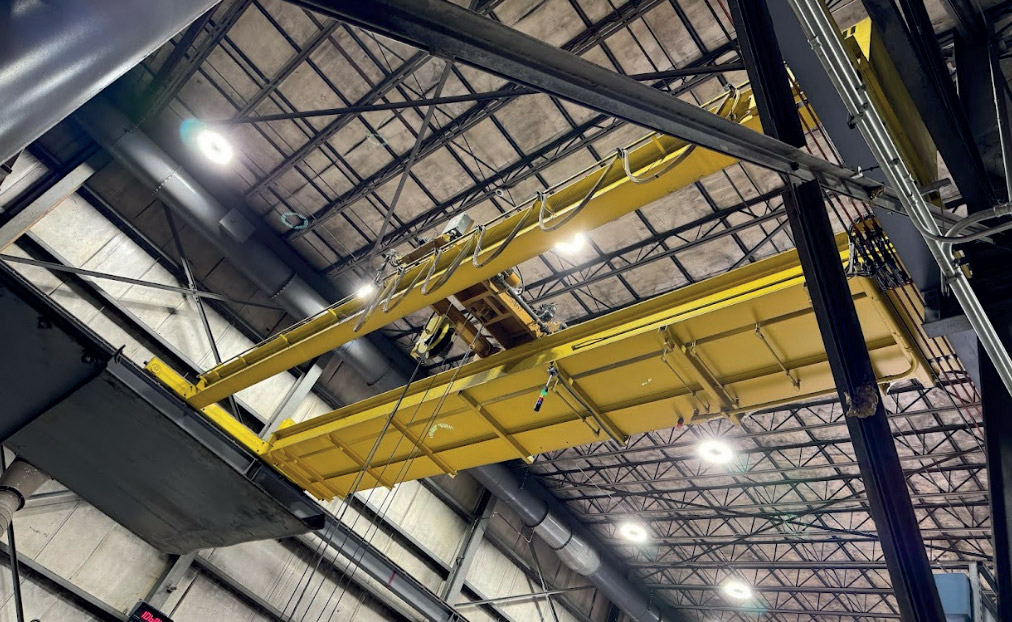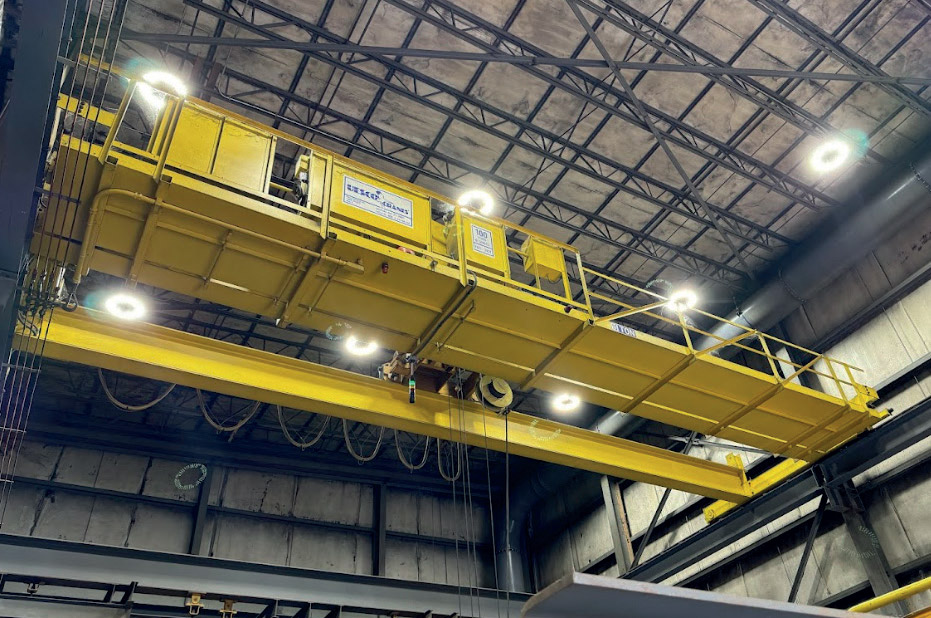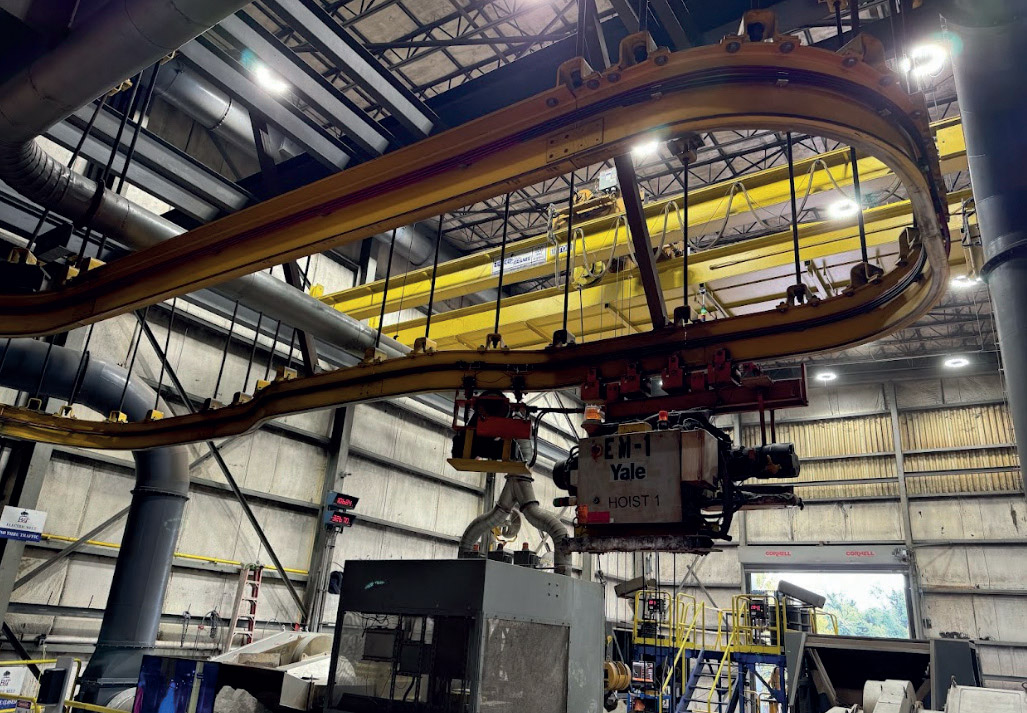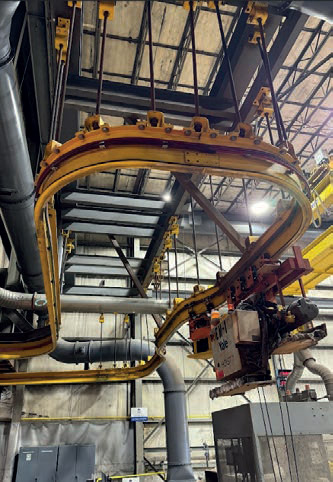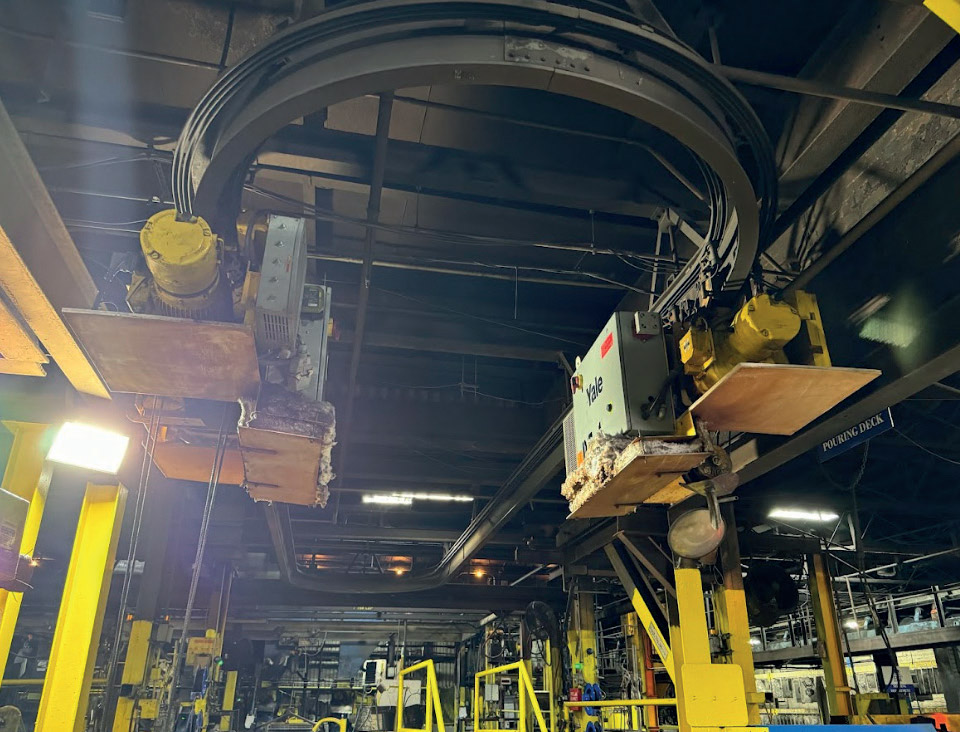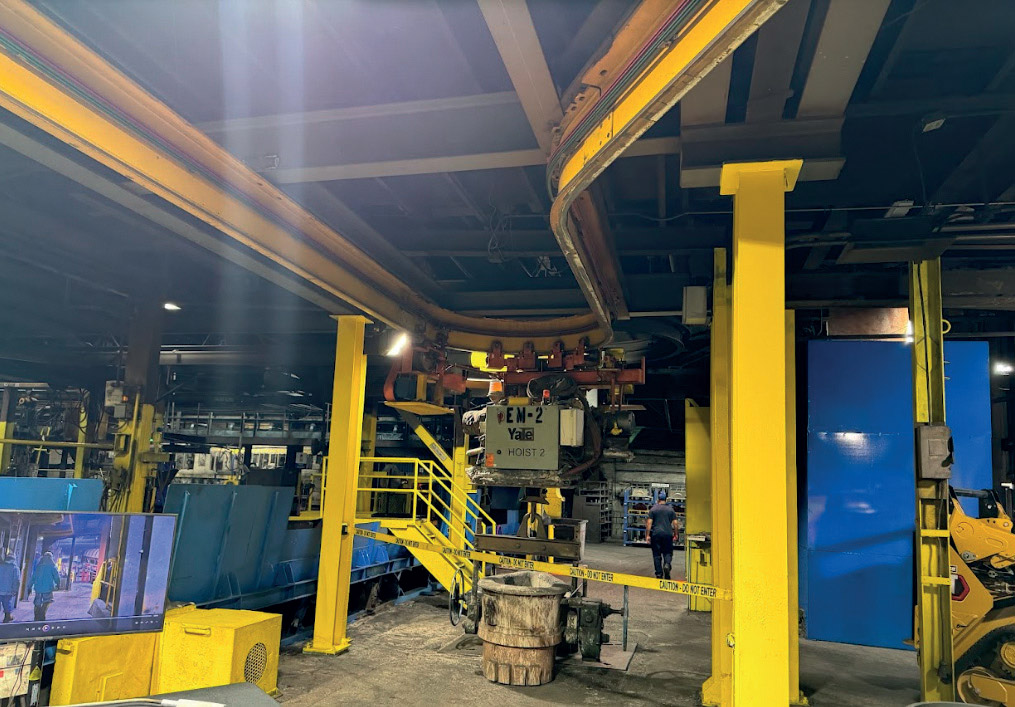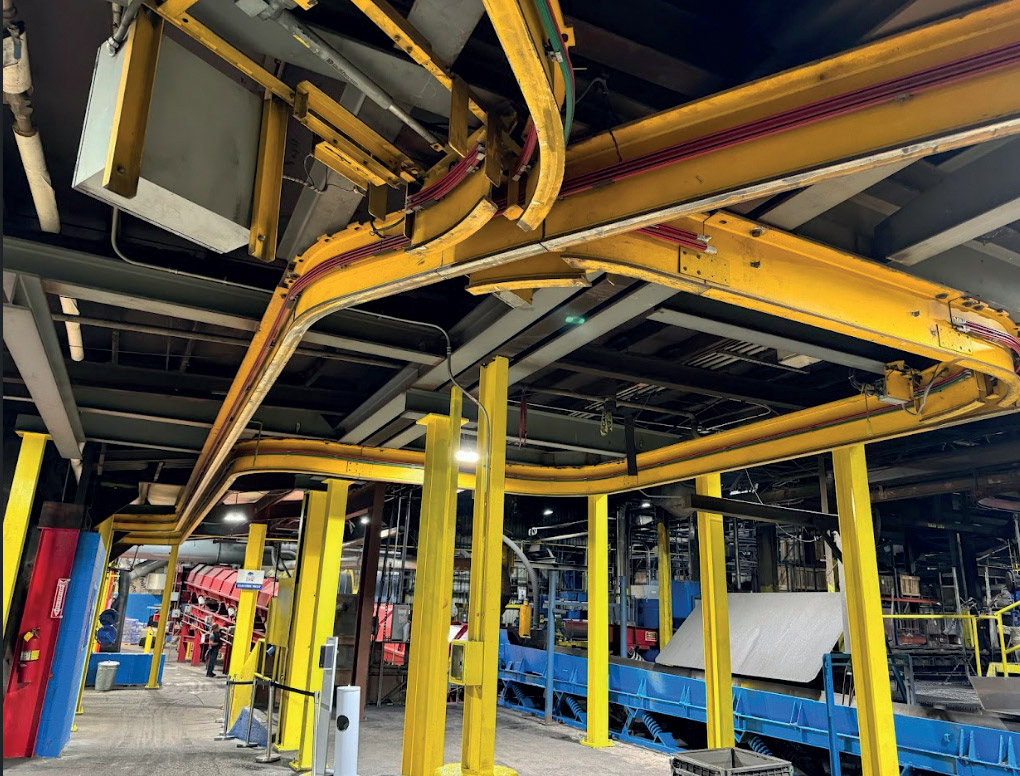Uesco Cranes
18 April 2024OCH reports on the benefits and challenges involved with Uesco Cranes' work for Bingham & Taylor's latest project...
The unveiling of a new electric melt system at Bingham & Taylor's Culpeper, Virginia, foundry has marked a new phase of collaboration between the company and Uesco Cranes.
Established in 1849, Bingham & Taylor serves the water and natural gas industries by providing safe and secure access to underground utilities. Transforming to a modern, environmentally and safety-sound facility required tens of millions of dollars’ worth of investment.
“A major portion of the transformation was converting from an old-style coke-fired furnace into a state-of-the-art electric induction melt furnace system,” explains Stephen McGuff, chief of manufacturing, Bingham & Taylor. “So that was the heart of the whole process, and that process required not only in-feed materials which required crane support, but then the molten metal process required a monorail hoist system to deliver from the furnaces to the moulding area.”
An important choice made by Bingham & Taylor was for crane equipment – but in this case, McGuff says that the selection was easy, inviting overhead crane manufacturer Uesco Cranes to handle this side of the project.
“Uesco Cranes had done a project for us years before in our plastics plant,” says McGuff. “They did an outstanding job with the design, build and customer service. We didn't even pursue any others for the new project. I just picked up the phone, called and said, 'Here's this project – will you start work on it?'”
Thinking back to the first project, McGuff recalls when he bought a used crane from an auction in Chicago. “I had never even heard of Uesco Cranes before buying the crane. When I looked on the label after buying the crane, I looked them up online, called and said: 'Well I bought this, now what do I do with it?'
Ryan D Marks, president, Uesco Cranes Industries Inc., and his team quickly jumped in “and designed the structure for that crane system and did an outstanding job in the injection moulding plant for us. It's lasted ten years now,” says McGuff. Discussing the latest project Marks explains that there were quite a few challenges.
“The building is very old – around 1900s – it's mostly a wood structure in the lower half of the building, and then, where they’ve put on additions and stuff, there are very high ceilings. So we had very high ceilings and very low ceilings to deal with. “We operated under the assumption that we could directly hang from the lower part of the building's joist network, and then realised pretty late into the project that actually, that was not going to be able to happen.”
Marks says that there were essentially two parts to this new project. One was getting the material to the furnaces where his team installed a 10-ton Magni Crane.
“The other challenge was to design a monorail loop with a safety track for functions like maintenance – to be able to transfer from the electric melt into the big ladle coming off the 3.0-ton Yale monorail and then getting it over to the smaller ladles and doing that transfer. I would say the whole project took about 18 to 19 months – and that was probably from initial discussions to commissioning.” “That was part of the other challenge in that clearly, this was a very fast-track project,” says McGuff. “It was being done in a fully operational foundry, and so we always had to work around the schedule of when the foundry was running.” While work was done post-Covid, it was still in a time when travel was limited and there were still many safety controls in place.
“All of that was going on at the same time with the complexities that Ryan pointed out of 'how do you build something within a fairly old structure that must not interfere with what's going on in the workplace',” says McGuff. “So, compliments to Ryan's team because they scheduled their work off hours and at weekends. They were there, diligently working through during the night. We'd come in and work around what they had built the previous night.
“At one point, we also realised… the challenges of the height in a certain area, where we had this gutter system that we thought we would be able to clear – but we ended up having to take this whole section of the roof off. So I was constantly throwing challenges at Ryan and his team.”
Marks describes how his team had to quickly mobilise and create an entire super-structure: “So in the lower half of the building, we had to create an entire free-standing structure that we could attach the monorail to – while trying to take into consideration the height concerns. At one point, Stephen [McGuff] actually had to put a pit in the floor because we were simply out of room. So far, it seems to have worked very nicely.”
The equipment that was used in the overall project was a Uesco Cranes double girder cab running magnet crane with an IMS 10-ton hoist.
The complete magnet controls came from Walker Magnetics, with the monorail system supplied by TC/ American. Meanwhile, two Yale Cable King hot metal hoists were used for hoisting applications.
“We also basically had to come up with a collision avoidance system, so we came up with a pretty complicated system that has different signals on it and strobe lights,” says Marks. “Because part of this monorail goes up like a ramp, almost like a walk area, you can't spread out the monorail enough to where things can just pass. You have to know when one is coming and one is going and make it stop without the operator having to do it because we have two hoists on the system that are supposed to be continuous loop, essentially.”
Another challenge was dealing with issues outside Uesco Cranes' control.
“We're the crane manufacturer and since we purchase the hoist, we are able to control those elements of the project,” says Marks. “We were controlling when we were manufacturing the crane – we know our engineering capabilities, etc.
“It was the things that we couldn't control that were probably the most frustrating – so the things that we were purchasing from TC American. Overall, they did a great job, but they were also having supply issues like everybody else. The Cable Kings – again, delivery issues. Everybody was going through this at that time. Overall, they delivered a very good product. [But] that part of the project – the building of the crane – ran fairly smoothly.
“When it came to the monorail, because we were relying on other suppliers, we were on their timeframe, rather than ours. When we found these things that needed to be manipulated and changed, we had to work with other people to get that done. When we designed the super-structure, again, that was my engineering team – so we were able to mobilise that very quickly, but waiting on other suppliers was one of the biggest challenges.”
Uesco Cranes had to use some of the new runway that the team put in as support structure for the monorail because of the different elevation changes: “From the top of the runway system where we put in the support structure, we are like at around 25ft to 28ft, and then we had to drop that into the lower part of the building,” says Marks.
“So we had to come up with a suspension rod system and different kinds of support structure to be able to get that elevation perfectly between those transitions. My team – my production staff, engineering staff, service department, my partners out there, distributor network... there's a lot of people playing into the success of this project.”
McGuff explains that during the project, there have been no accidents, no first aids and no near misses: “The safety protocol that we put in place – that was key to all the contractors. The pre-training, the communications… were paramount to that.”
Environmentally, the project has also been a success, reducing CO emissions by 98% and increasing recycled content abilities for products to contain greater than 99% recycled content. The new system has also boosted production capacity, and improved safety levels.
“We have basically reduced carbon dioxide and carbon monoxide levels by around 98%,” says McGuff. After the new furnaces were brought online, the old ones were scuttled. The site is also so much cleaner now, as a result of this new technology.”
“From the equipment perspective, when we were originally in there, Bingham & Taylor didn't know what the requirements were for aspects like overhead lifting,” says Marks. “They had some units in there that didn't meet some of the requirements.
So the fact that we were able to upgrade to true hot metal hoists and all of the safety that was required for that, and even with the magnet crane (e.g some of the safety features on there such as warning lights to help operators stay safe) – always at the front of mind was 'how can we get them the best equipment, the safest equipment and the most operator-friendly equipment as possible?'
“That was always at the front of mind throughout the entire project.”
Asked for his final thoughts on the project, McGuff says: “Ryan said: ‘We're committed to this, we're going to find a way to make it happen.’ The final solution has been outstanding. There hasn't been any downtime since the project started. It's doing what we set out to do.”
“The thing is, we couldn't possibly have known about these challenges at the time until we got into the project,” adds Marks. “There were too many unknowns, such as the age of the building and those kinds of things that affected how the project went. So there were a lot of planning sessions with my team and then consulting with Stephen about whether this was feasible or not. He was also able to look at the situation and to assess whether certain solutions would work.
“It was really more of a collaborative effort, and while this latest project has posed more challenges than the first [one], it has solidified the friendship between not only Uesco Cranes and Bingham & Taylor, but between Stephen and myself.”
